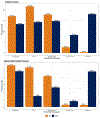Comparing electrical stimulation functional mapping with subdural electrodes and stereoelectroencephalography
- PMID: 36872854
- PMCID: PMC10239361
- DOI: 10.1111/epi.17575
Comparing electrical stimulation functional mapping with subdural electrodes and stereoelectroencephalography
Abstract
Objective: Electrical stimulation mapping (ESM) is the clinical standard for functional localization with subdural electrodes (SDE). As stereoelectroencephalography (SEEG) has emerged as an alternative option, we compared functional responses, afterdischarges (ADs), and unwanted ESM-induced seizures (EISs) between the two electrode types.
Methods: Incidence and current thresholds for functional responses (sensory, motor, speech/language), ADs, and EISs were compared between SDE and SEEG using mixed models incorporating relevant covariates.
Results: We identified 67 SEEG ESM and 106 SDE ESM patients (7207 and 4980 stimulated contacts, respectively). We found similar incidence of language and motor responses between electrode types; however, more SEEG patients reported sensory responses. ADs and EISs occurred less commonly with SEEG than SDE. Current thresholds for language, face motor, and upper extremity (UE) motor responses and EIS significantly decreased with age. However, they were not affected by electrode type, premedication, or dominant hemispheric stimulation. AD thresholds were higher with SEEG than with SDE. For SEEG ESM, language thresholds remained below AD thresholds up to 26 years of age, whereas this relationship was inverse for SDE. Also, face and UE motor thresholds fell below AD thresholds at earlier ages for SEEG than SDE. AD and EIS thresholds were not affected by premedication.
Significance: SEEG and SDE have clinically relevant differences for functional brain mapping with electrical stimulation. Although evaluation of language and motor regions is comparable between SEEG and SDE, SEEG offers a higher likelihood of identifying sensory areas. A lower incidence of ADs and EISs, and a favorable relationship between functional and AD thresholds suggest superior safety and neurophysiologic validity for SEEG ESM than SDE ESM.
Keywords: drug-resistant epilepsy; functional brain mapping intracranial EEG.
© 2023 International League Against Epilepsy.
Conflict of interest statement
RA receives research support from NIH NINDS R01 NS115929 and Cincinnati Children’s Research Foundation (Research Innovation Project Grant). None of the other authors have any relevant potential conflicts of interest to report.
Figures



References
-
- Jayakar P, Gaillard WD, Tripathi M, et al. Diagnostic test utilization in evaluation for resective epilepsy surgery in children. Epilepsia 2014;55:507–518. - PubMed
-
- Gavvala J, Zafar M, Sinha SR, Kalamangalam G, Schuele S, American Seeg Consortium sbTACNS. Stereotactic EEG Practices: A Survey of United States Tertiary Referral Epilepsy Centers. Journal of clinical neurophysiology : official publication of the American Electroencephalographic Society 2022;39:474–480. - PubMed
-
- Serletis D, Bulacio J, Bingaman W, Najm I, Gonzalez-Martinez J. The stereotactic approach for mapping epileptic networks: a prospective study of 200 patients. Journal of neurosurgery 2014;121:1239–1246. - PubMed
-
- Alomar S, Jones J, Maldonado A, Gonzalez-Martinez J. The Stereo-Electroencephalography Methodology. Neurosurgery clinics of North America 2016;27:83–95. - PubMed
-
- Trebuchon A, Chauvel P. Electrical Stimulation for Seizure Induction and Functional Mapping in Stereoelectroencephalography. Journal of clinical neurophysiology : official publication of the American Electroencephalographic Society 2016;33:511–521. - PubMed
Publication types
MeSH terms
Grants and funding
LinkOut - more resources
Full Text Sources
Research Materials

